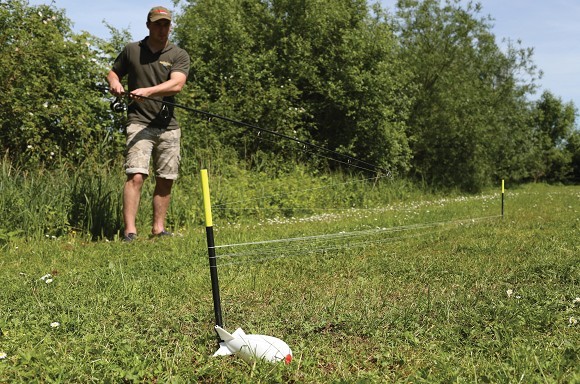
Hit the spot
There are many ways to hit your ‘that’s-a-bite’ spot each time – unfortunately though, most of the time we’re not actually hitting it. Here’s Taska's Marcus Barrowcliffe's guide to mastering Marker Sticks
1 First things first
I’ve found my spot with my marker, I now want to clip-up my actual angling rod and spod rod to that spot, so what do I do first? Reel the marker float back down to the lead and then clip it up?
“No, cast a bare lead to the marker float with one of the fishing rods and once you’re happy with the drop being on the same spot, clip-up it up. This means the lead will hit the same spot despite a difference in line stretch between the marker and fishing rods.”
2 Rod angles then...
What about the angle at which I hold the rod – how important is that?
“This is very important element to consider if you want all your casts to hit the same distance. Hit one cast with the rod held 45-degrees forward and the next with the rod held vertically and you could reduce your distance by ten-feet or more.”
3 Onto the sticks
I’m all clipped-up, but what’s the technique when it comes to wrapping the line around the marker sticks and have any tips?
“Firstly, I set my Range Sticks in the ground angled outwards slightly – this ensures the line won’t slide off halfway through wrapping-up. After that it’s a simple case of securing the lead around one stick and wrapping the line between the two until I reach the clip and then using a Peg Marker to record the potential final ‘part’ wrap.”
4 So they're bang-on now?
So once I’ve counted out how many wraps the marker rod is, if I do exactly the same with my actual fishing rod, both leads (marker and actual fishing rod) should be at exactly the same distance?
“Hmm, not necessarily. As I pointed out earlier, there is sometimes line stretch to consider and also any side wind. The marker tightened down to the lead won’t be effected by this but a cast will – and a large bow in the line will create extra distance.”
5 The spod rod
What about the spod rod – do I count out the same number of wraps or is that different too as that’s landing on the surface and not swinging back down to the lakebed like my marker/actual fishing rod?
“Yes, you need to allow for this. As a rule of thumb, in depths over ten-feet I’ll reduce the spod distance by one third of the depth; one quarter the depth in water when five-to ten-feet deep and not at all in depths five-feet deep or less. This always ensures the bait falls just behind the rig.”
6 Nightmare crosswinds
Any tips for casting in a crosswind?
“Firstly I’ll line-up and try, when possible, to cast in-between the stronger gusts of wind. I’ll also use a slightly heavier lead to try and reduce any bow in the line. The lead will also follow the bow in the line as it drops to the bottom, which is a very important observation and you need to allow for this.”
7 The advantages
Finally, can you list the advantages of using distance sticks over walking out your rods?
“Speed; efficiency; higher accuracy; you don’t need a lot of room; your main line stays off the ground and away from mud etc.; there’s no risk of branches or other anglers becoming tangled in your line and potentially damaging it; and best of all you remain close to your other rods fishing out in the lake.”




